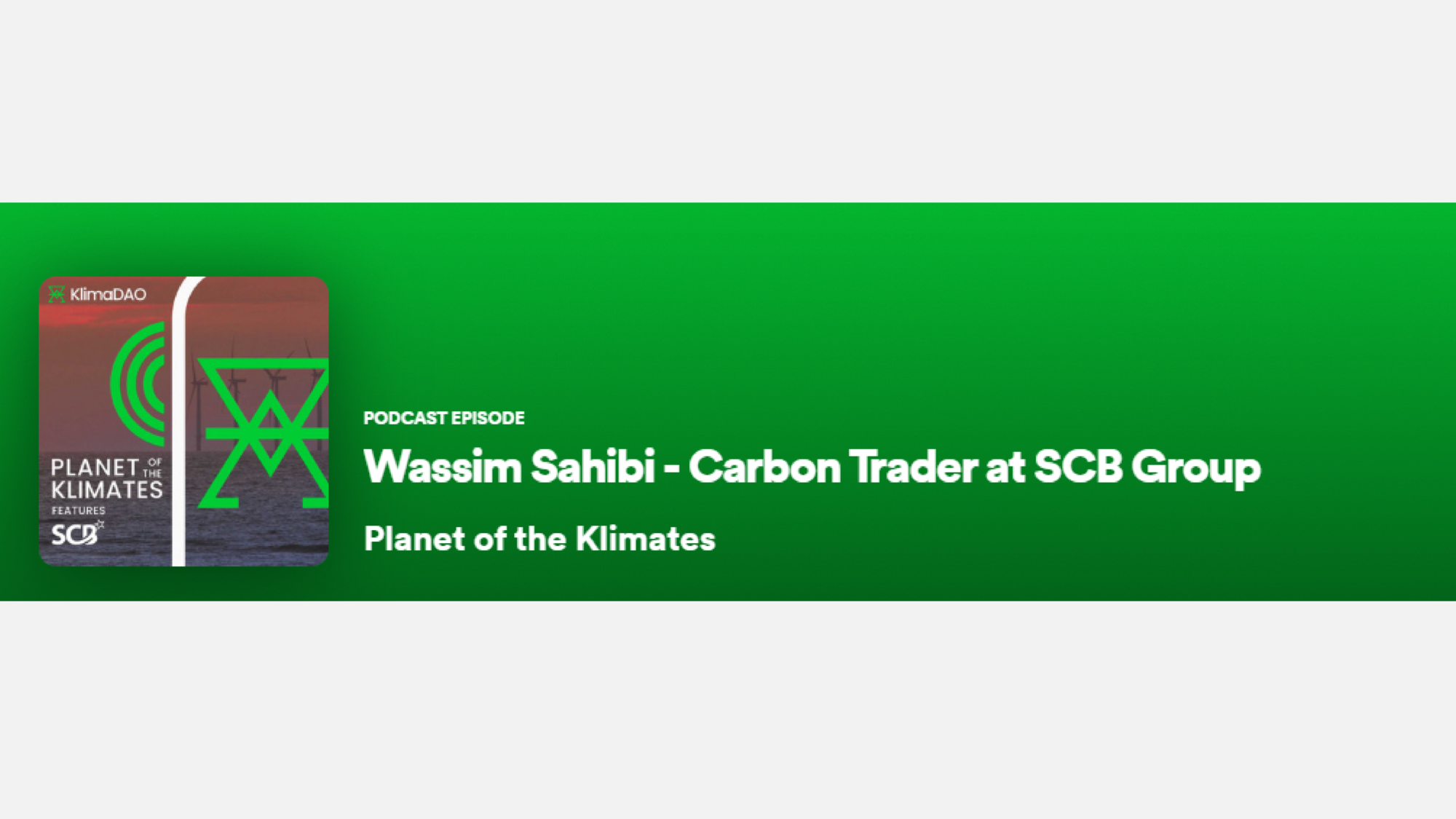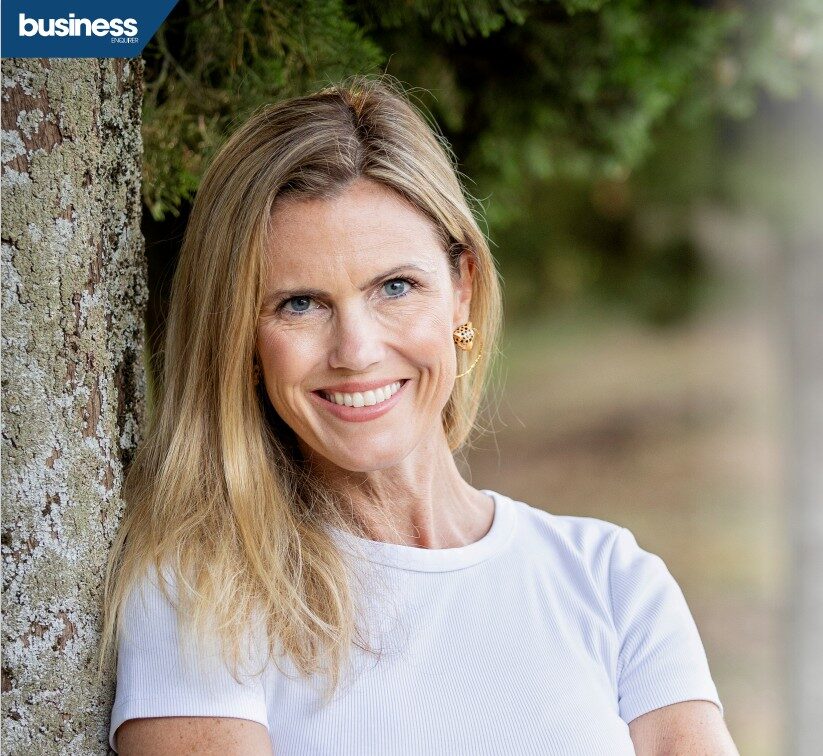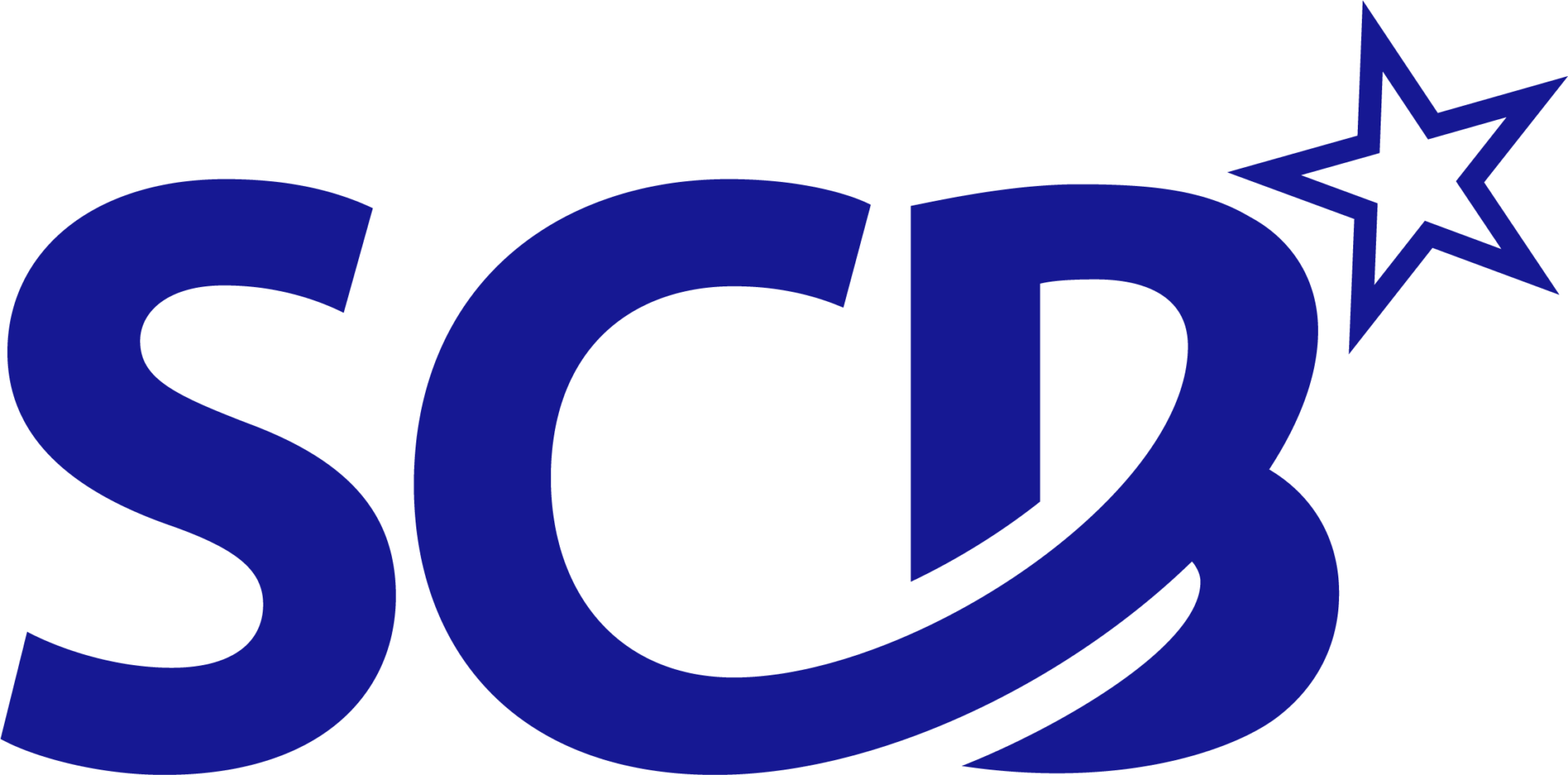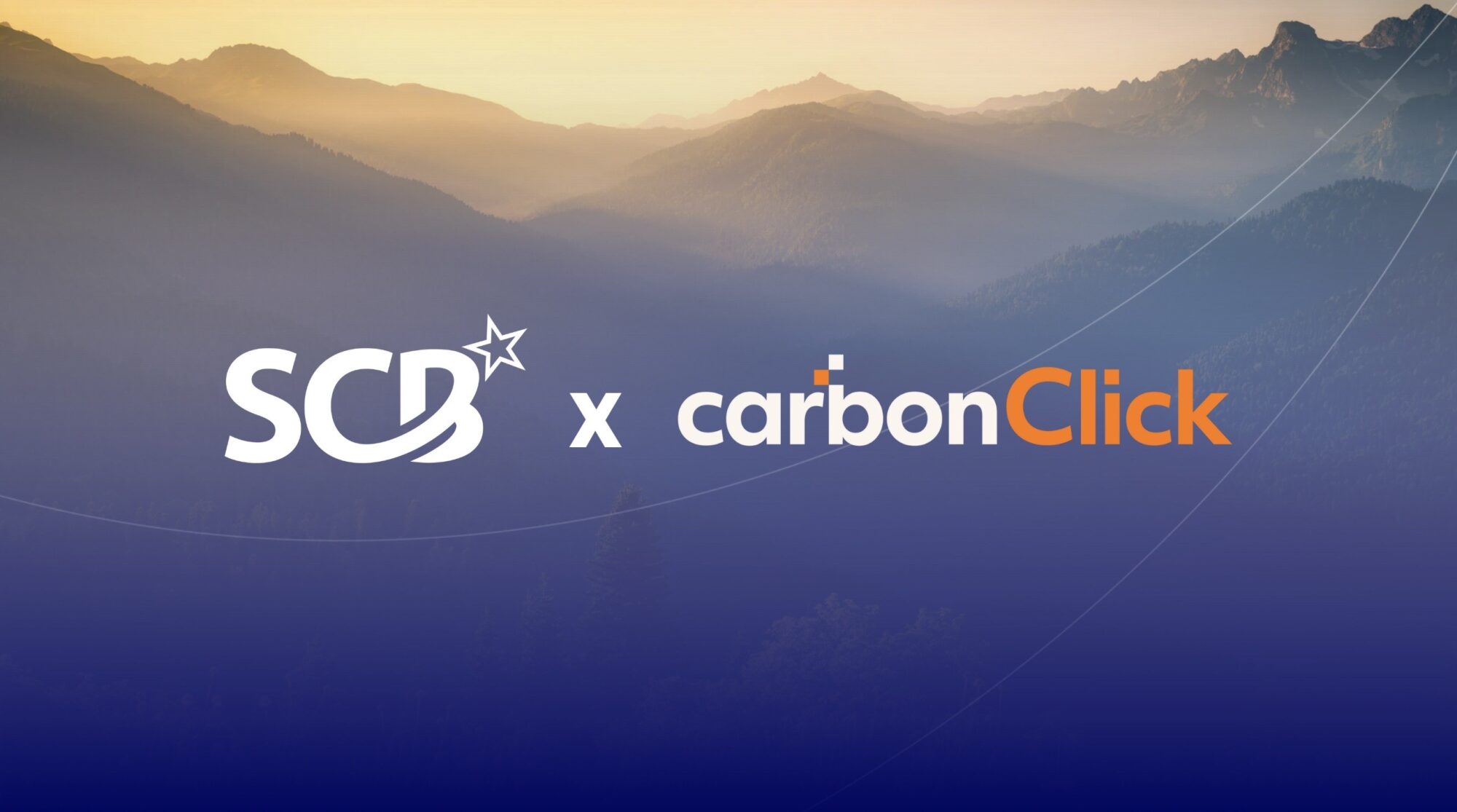SCB Carbon Trader’s interview with the founders of Klima, a blockchain protocol backed by carbon credits explores the intersection of carbon credits and blockchain technology.
Read our summary below and listen to the original podcast here or wherever you get your podcasts:
Planet of the Klimates S01 E19 – Wassim Sahibi – Carbon Trader at SCB Group
https://rss.com/podcasts/potk/502209/
KlimaDAO: Wassim Sahibi is an experienced carbon and EAC’s trader. He’s a long-time evangelist of blockchain technology and its capabilities to help propel the voluntary carbon market (VCM) forward. He joins Phaedrus and DiamondHands to discuss the large impact carbon projects have on communities and the importance of tackling the climate crisis from many angles.
Wassim is a trader and portfolio manager at SCB, a leading global carbon commodity company. SCB also happens to be one of our newest Klima Infinity partners, so we’ll take some time to unpack and understand just what SCB is all about and take a glimpse at the future of this incredible partnership. Let us know about you.
Wassim Sahibi, SCB: I have an engineering background, I studied energy, finance and data analytics. My first job was in R&D, I worked in the design of solar panels, integrated into the structural elements of the buildings. Then moved to strategy consulting in the sector of energy and mobility. And after that I developed a project in Morocco in my country of origin. I came back to Switzerland and moved to the voluntary carbon market (VCM) it’s a super interesting market and I could see that it was boiling, and I joined SCB.
For my crypto experience, I’ve been around crypto since 2015, really involved. I was in a group of people in my Uni. where we were very interested about blockchain in general. I’ve been through a few bull and bear markets.
With my colleague, one of our first comments was that carbon credits need to be on blockchain, they lay themselves perfectly on the blockchain, everything blockchain is made for that it can enable and help, is needed by the carbon market, especially the VCM. A bit of time later we see Klima and Toucan happening.
I work as a carbon and EACs, environmental trader, I also take care of crypto, ReFi partnerships. And I do a lot of data analytics for the desk. Take care also of the price modeling for all the carbon assets that we trade. As a commodity it is pretty scattered, and the prices are very different.
KlimaDAO: Great to hear about your background, you were an early adopter for crypto and blockchain technology. It’s great to hear that vision of the aligning, that carbon markets belong on-chain, too. That was on your radar quite early.
What is SCB’s mission?
Wassim: SCB has been working in the low carbon commodity markets now for 15 years. That makes us a heritage business. We have mainly two tracks of business. The first is assisting companies achieving net zero by substituting low carbon commodities for high carbon commodities. To give an example, reducing the amount of gasoline fuel for cars and increasing the amount of Ethanol. So that’s one track.
The second one is helping companies basically achieve carbon neutrality or even going beyond carbon neutrality through carbon credits to offsets or abate their residual emissions. We help companies assess their carbon emissions, set sustainability goals, and abate their residual emissions through carbon offsets that make sense, in regard to their operations for example. Or to their whole environmental strategy.
We also became more active in the upstream side of the carbon market. We finance and co-develop highly additional and high-quality carbon projects. I can give you a few examples.
We funded and co-developed a solar power project for an adult literacy programme, basically we’re doing it with buildOn, building nine schools in Malawi, some of our colleagues went there on the ground. Today we have more than 6,000 children and 700 adults benefit from the increased access to education that this programme, these lights, these classes have provided.
We’re also financing the planting of 4 million trees in the Himalayan region of northeast India. It’s a region that is at risk of landslides, so these trees prevent the risk of landslide. They are also due to remove more than 360,000 tonnes of CO2 from the atmosphere, improve biodiversity, and support the local communities and create jobs. This project is expected to help 5,000 people benefit directly from it. Indirectly we’re talking about more than 16,000 households.
One of the projects I really like is with a Rohingya refugee camp in Bangladesh, we are the sole provider of 100,000 smokeless cookstoves it’s a device that really improves the health and the living conditions of people. In this situation the living conditions are really hard. We’re working in partnership with Bangladesh Bhundu Foundation, and we are supported by the government of Bangladesh. The distribution started in April and is to be completed in February 2023.
KlimaDAO: That’s awesome. You are a carbon trader, you would think that is a technical, computational, analytical role, and you have the opportunity to impact things on the ground with these very specific projects. That’s got to feel good.
Wassim: That’s the beauty of the carbon market. It’s still a market, we’re still traders, we are doing a technical job, but we have an impact. That’s what makes our job so pleasant because we have a daily impact on the planet, on communities, on biodiversity, and probably more people will apply for carbon trading roles now.
KlimaDAO: You’ve talked about impact in developing countries, building schools, benefitting kids, adults, planting trees. Making money’s important. Really making an impact that’s the true value a company can do. We’re in the carbon removal business. To see a company like SCB do this really makes us inspired to be with you guys, rubbing shoulders.
Wassim: I think our values are aligned to make the world a better place.
KlimaDAO: As a carbon trader, what role do carbon credits play in the bigger picture of climate action, there are critics out there what do you say to them about the impact and the benefit of these carbon credits?
What role do carbon credits play in the bigger picture of climate action?
Wassim: There are big programs such as for example CDM which came under scrutiny by a UN investigation around 10 years ago and they identified room for improvement. We are always talking about how to improve this market and how to have an impact.
We have now major offset programmes like Gold Standard, or Verra, they do their best to respond to these concerns and put in place methodologies and methods to prevent overestimation of greenhouse gas for example and to reconsider the eligibility of projects and they take action.
If someone wants to question the legitimacy of carbon trading or carbon credits, you can see that interest in carbon credit has grown a lot since COP 26, when the UN decided to adopt a market-based solution, among government traded emissions. So I don’t think we would see massive involvement of all these bodies if it was not a legitimate solution or if there was no impact. And on my side, being part of the carbon credits ecosystem, I can see, as I described with the project before, I can see that the nature-based projects, the removal projects, the renewable energy projects, the community-based projects in addition to their clear environmental impact, have also benefits in terms of biodiversity, for the local communities and for the society.
In some projects that we support, we have infrared cameras or satellites that are tracking land use, and we can see the return of wildlife, we can see the forest coverage growing and improving. We have also direct contact with communities in the avoidance projects that we develop and we are able to see the impacts that these projects have on their lives and on their health on a daily basis.
So that’s what I say to these critics, right? And I also maintain something to be very transparent to fight climate change it’s a fight that needs to happen on a lot of different fronts. And VCM is just one of them.
KlimaDAO: Highquality vs low quality, what’s your thoughts on these kinds of discussions?
Wassim: What’s the definition of high and low quality? We can say high-quality would be removal activities, but for me the most important is additionality. An easy example is a wind farm, it is likely to be easily financed if it is accessible, if its in a stable environment, but projects that have difficult access will be harder to finance, through business channels, and that’s where carbon credits make a difference.
Now the verification of Verra and Gold Standard is becoming more strict, they will not, for example, verify renewable energy projects that are not in least developed countries. I hear people saying that it’s not doing enough to address climate change, as I said before, climate change needs to be addressed by a lot of means, one of them is the voluntary carbon market and in order to address this climate crisis we need to incrementally change the market and make higher quality credits, but that should be incremental, just like you guys have been doing with BCT for example. So you want to make it higher quality, and you’re doing it in an incremental way, you don’t want big market moves, or big disruptions/discrepancies.
KlimaDAO: Over time it will just balance off by itself.
Wassim: A lot of the quality talk is sometimes about perception, for example about vintages, the climate crisis or the rise in temperature in the planet is a perpetual auto-feeding circle. Let’s take the North Pole, there is snow, it helps to cool the planet, it reflects energy. If you take away the caps now, it will melt the snow, underneath is rocks or water, that will absorb heat and make the ice melt faster which will expose more rocks and make the planet warmer and warmer.
One can say that a carbon credit of 2001, if it was well monitored and the project is legit, one ton of removal had way more impact than a ton of removal in 2021. If it is a legit project that was built 10 years ago let’s say, or 5 years ago, you already know that these 5 years nothing happened with the project, no bad press, everything is legit there, while a project that you buy in 2022, you don’t know what’s going to happen.
Sometimes it’s perception, for example waste credits. There is a lot of bad press around waste credits, but you can also see some people say that they are highly additional because in LDCs they solve the waste problem, there’s no reason, there’s no financial reason except the carbon credits, because in some countries there is not much budget to help with this. So there is a big perception side to all of these quality problems, and I just wanted to share, there are other perceptions than waste = bad; reforestation = good.
Blockchain’s potential, as a tool to address some of the challenges around the climate crisis
KlimaDAO: You mentioned earlier that when you joined SCB it was really on your radar quite early that VCM belongs on-chain. So I’m curious, what were your views on blockchain’s potential, as a tool to address some of the challenges around the climate crisis?
Wassim: When you start learning about carbon credits, we are doing just the VCM, so double-counting risks, the delivery risk when you are a trader, for example, the lack of liquidity, the lack of transparency especially at the very beginning of the carbon markets.
Then you see what happened when blockchain met carbon and crypto met carbon, you have massive liquidity, transparency in prices, projects in wallets, who is holding what. That makes it easy to access offsets, not to name any project, they can monitor the price of any BCT or NCT or any transparent pool, and whenever it’s a good price for them they can buy. The liquidity is so deep that it’s not going to generate that much of a slippage.
Individuals, it’s the same thing, they have access they know what’s underlying, in the pool, so that’s on the end user on the downstream of the market that’s how I see blockchain helping for the moment, and more upstream, I would say more offset holders can sell or buy offsets very easily on-chain with transaction fees that are close to zero, especially with the Matic price now, and then also project owners and project developers can sell a part of their credits immediately on the blockchain and use this liquidity to pay back their operations and hopefully make some profit.
I’m also referring to other amazing tools that are created, thinking about all the retirement tools, Klima Infinity for example, a very sleek way to retire credits and understand, it’s very easy to grasp what you’re doing and what type of projects you’re supporting, you can be selective according to the granularity of the project.
Listen to the whole interview here: https://rss.com/podcasts/potk/502209/
Learn more about KlimaDAO on their Website: https://www.klimadao.finance/



